It’s been a few months since we last checked in on Historic. In that time, many cards have entered the format, but not a lot has changed. The releases of Kaladesh Remastered and Zendikar Rising have added a couple new archetypes to Historic, but they’ve mainly strengthened existing decks. Cards like the fast lands, modal DFC lands, Forsaken Monument, and Bomat Courier have powered up various decks and pushed them to new heights.
Our Historic Tier List here at Card Kingdom is focused on ladder play. Our goal is to give you a snapshot of what you can expect on the Arena ladder this week, but individual tournament metagames may vary.
Before we dive into the list, here’s a quick refresher on the grading criteria:
S Tier: Decks that are above the rest. This is normally the default “best deck in the format” and the deck(s) you should have in mind when building or picking your deck.
A Tier: Decks that are great. These decks are knocking on the door of S Tier, but they may have a small weakness that keeps them out of the upper echelon.
B Tier: Good, solid decks. You wouldn’t be surprised if a B Tier deck takes down an event, but they have bigger weaknesses or liabilities than the decks in A Tier.
C Tier: Decks that are totally fine, but not notable. These decks aren’t exactly tearing up the tournament or ladder scene, but you should expect to face them every now and then.
D Tier: Decks with strong elements, but that generally aren’t great choices compared to the rest of the format.


Gruul
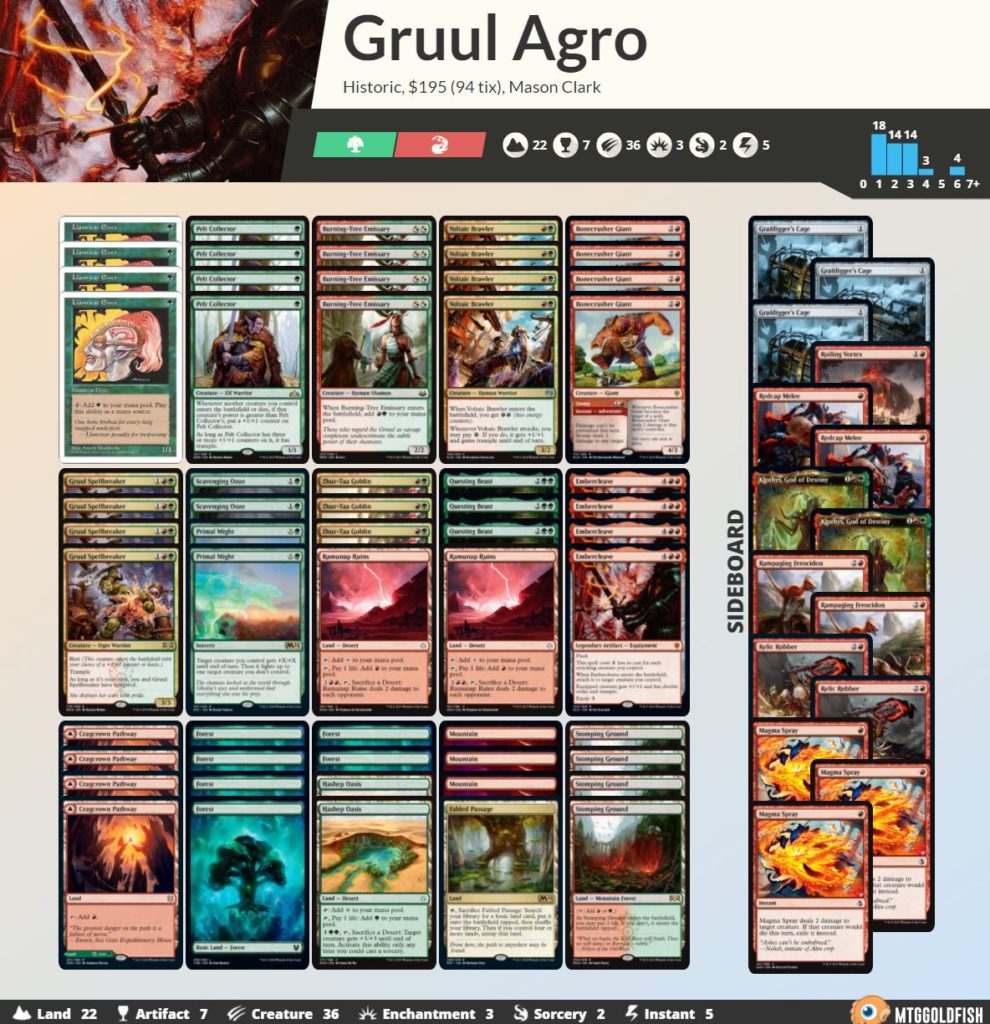
Buy this deck from Card Kingdom
Export this deck to Arena via MTGGoldfish
The king is BACK! Gruul was one of the OG menaces in Historic, and it has returned to take the crown. Burning-Tree Emissary’s suspension and the lack of a Pathway kept the deck off our last tier list, but now it’s back with a vengeance. Gruul is the epitome of a curve-out deck, and unlike other aggro decks, it can survive and win even if its curve gets disrupted. Combine that with the potential for blazing fast starts and you have a clear S-Tier deck on your hands.
Jund
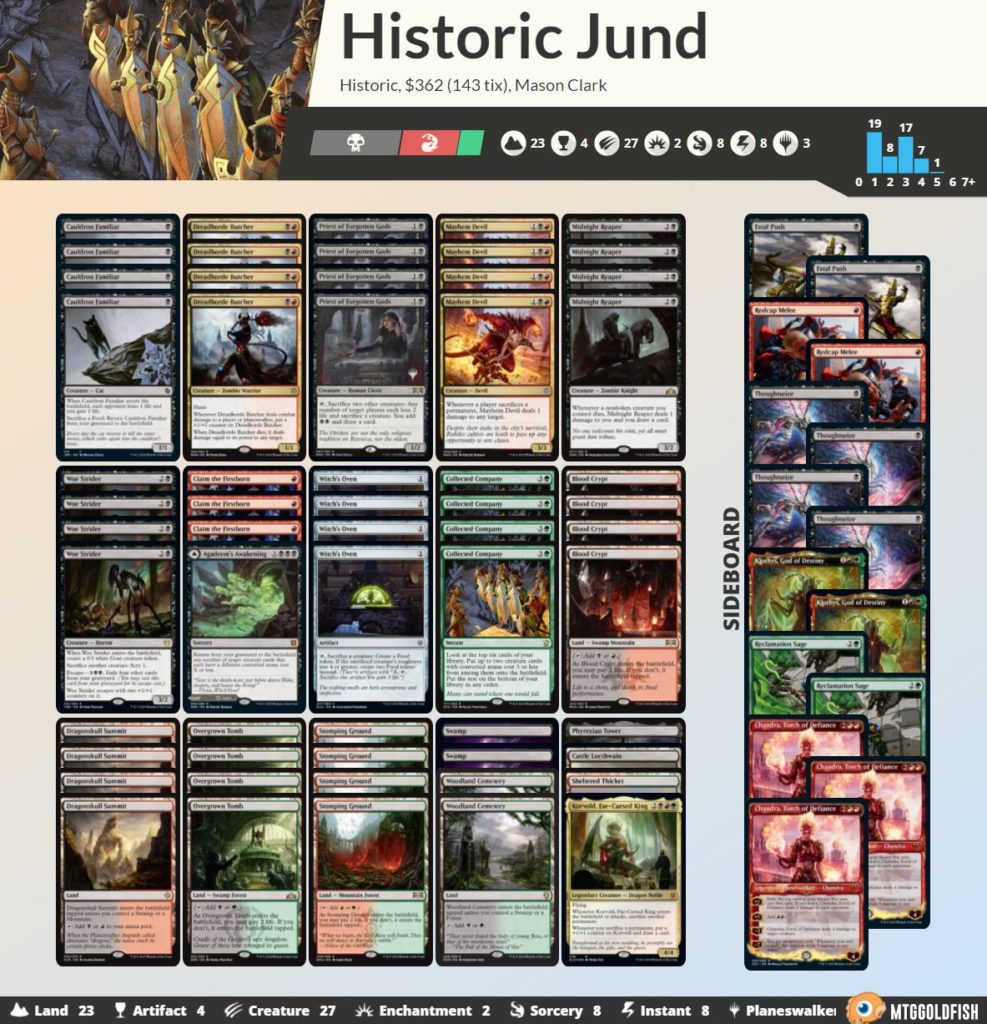
Buy this deck from Card Kingdom
Export this deck to Arena via MTGGoldfish
Jund was the best deck when we last checked in on Historic, and it remains at the top of the heap. The deck still includes powerful cards like Mayhem Devil and Claim the Firstborn for powerful early game interaction, but the Collected Company version of the deck has completely supplanted the Bolas’s Citadel build we saw before the last Mythic Invitational. This swap has allowed the deck to have more functional and consistent draws; the ability to reliably find your Devils and other pieces allow this synergy deck to truly dominate. The other major upgrade this deck received was Fatal Push in Kaladesh Remastered, which comes in out of the board against aggressive decks.
The only real knock against Jund these days is that everyone seems to have a plan for it. Most sideboards include everything from Grafdigger’s Cage to Leyline of Combustion. Nonetheless, the deck has remained a top player in the format, and you should be ready to face it at your next Historic event.
Sultai
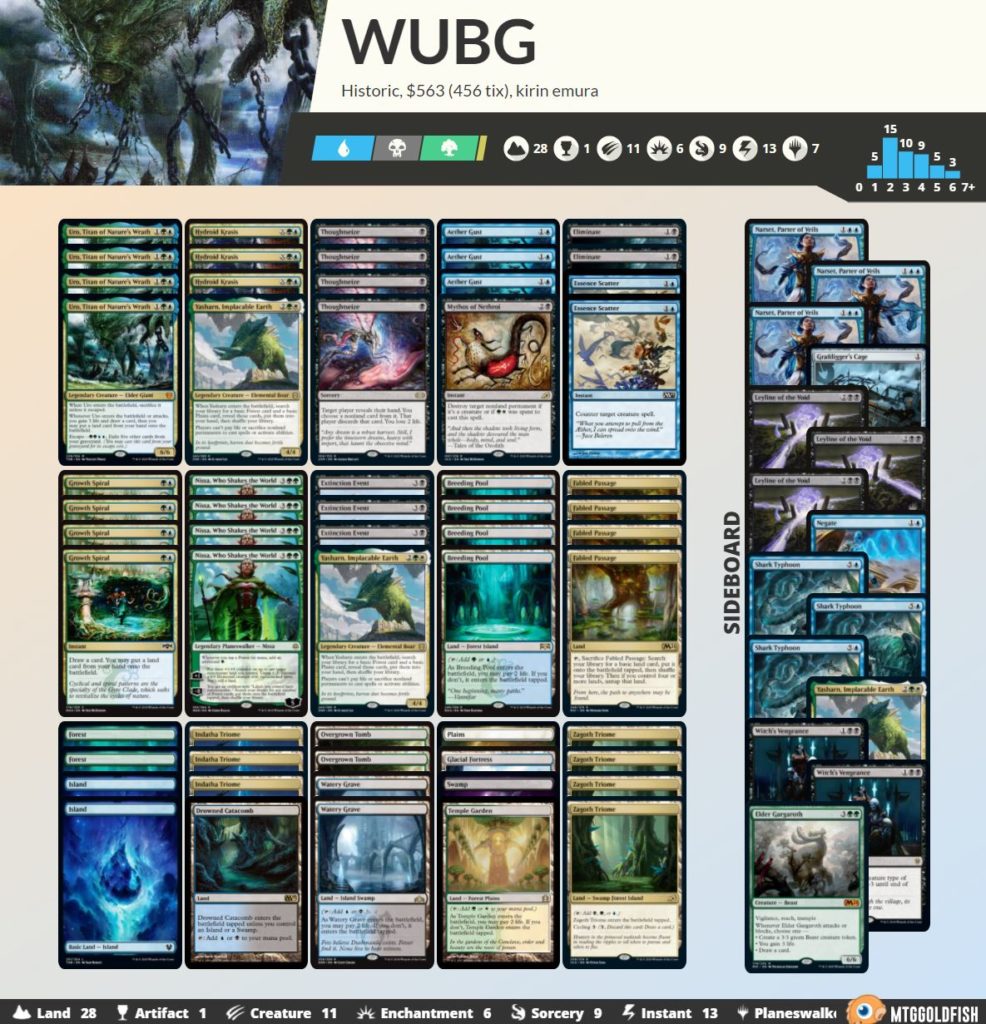
Buy this deck from Card Kingdom
Export this deck to Arena via MTGGoldfish
Like Jund, Sultai also remains largely unchanged since September. The formula of early interaction, Uro and Nissa that dominated Standard continues to play a large role in Historic.
There’s another version of Sultai that was popularized by CFB that we are highlighting simply for its innovation and place in the metagame. “Four Color Turbo Pig,” as LSV calls it, is a Sultai deck splashing white for Yasharn. Yasharn is not only a haymaker versus sacrifice decks, but also impactful in other match-ups. Trying to turbo out a Muxus with Skirk Prospector? Trying to activate your Aetherworks Marvel? Trying to combo off with your Neo-Storm deck? The pig negates all of it. The deck may ask more of your mana base, but it’s not the world’s biggest stretch. This is the build of Sultai I’d suggest you play if you think Marvel and Jund are going to be popular choices.

Auras
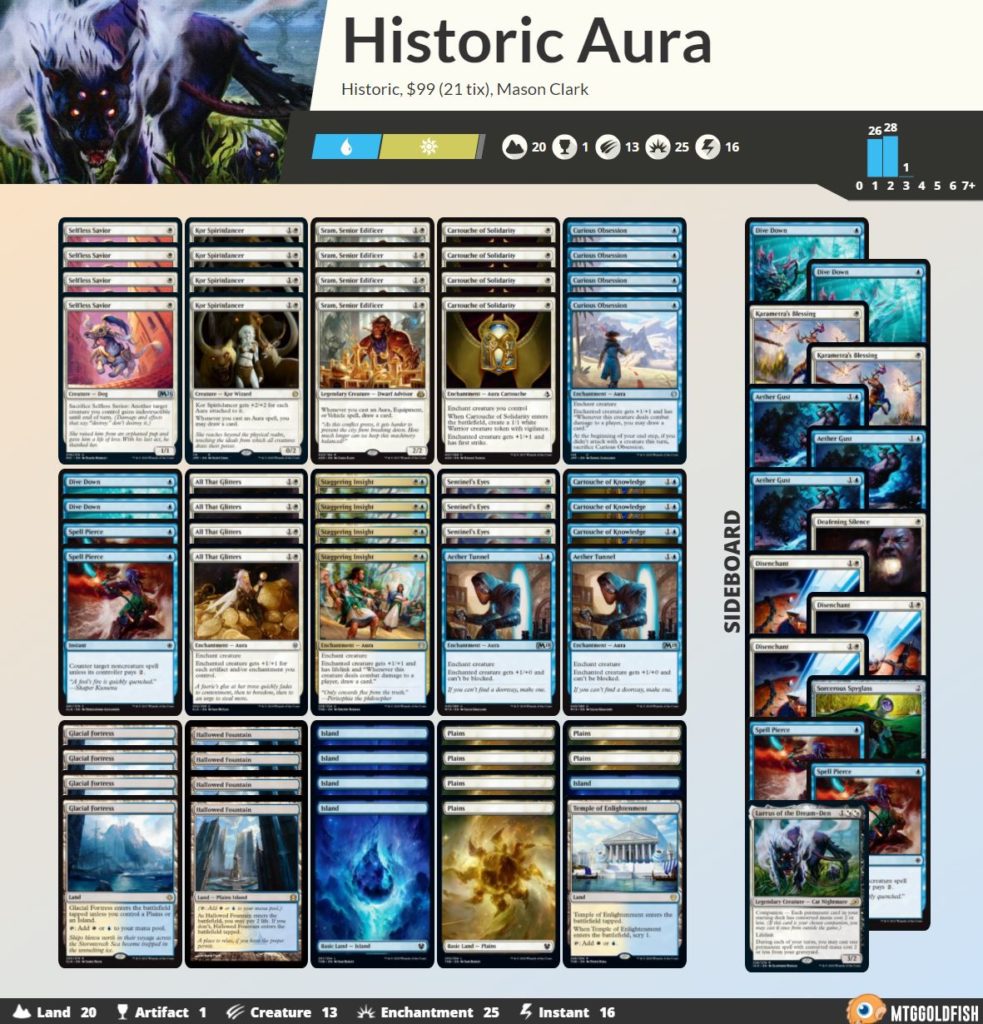
Buy this deck from Card Kingdom
Export this deck to Arena via MTGGoldfish
Auras has been a staple of the format since Jumpstart’s release, and it remains one of the better proactive decks in Historic. It dodges almost all the hate in the format, and it even picked up Sram from Kaladesh to increase its consistency. This entry in the tier list covers all Auras variants, including both the popular Blue-White version and the new Black-White build I previewed here on Card Kingdom last week.
These decks each have big perks. The Blue-White build has better auras but worse mana; Black-White has the opposite, thanks to a Pathway and Concealed Courtyard. I’ve leaned toward Blue-White simply because its cards are too good to pass up. Once the Blue-White deck gets better mana — or Black-White gets better auras — I expect this deck to jump up to S tier; until then, both decks have enough flaws to keep them in A tier.
Rakdos

Buy this deck from Card Kingdom
Export this deck to Arena via MTGGoldfish
Rakdos Pyromancer has also had a steady presence in Historic since Jumpstart, but it gets some major upgrades with Kaladesh. Fatal Push is exactly the kind of removal spell this deck wants, and when combined with Chandra, Rakdos can grind most decks out while still presenting a fairly good clock.
This deck has a real weakness to graveyard hate cards like Rest in Peace, Grafdigger’s Cage and Leyline of the Void, but those cards are still beatable. Feed the Swarm is a new addition from Zendikar Rising that allows you to answer enchantments, and because it doubles as a creature-removal spell, it’s rarely a dead card. You also have Hazoret as a Plan B to ignore the graveyard hate and just beat down.
Despite its flexibility, Rakdos is still an A-tier deck. Sometimes, your draws can be a bit clunky, and you really need to tune your deck to the expected metagame. This deck is very reactive, and it really shines in tournaments with open decklists — but since this tier list is focused on ladder play, I have to dock it a few points.
Goblins
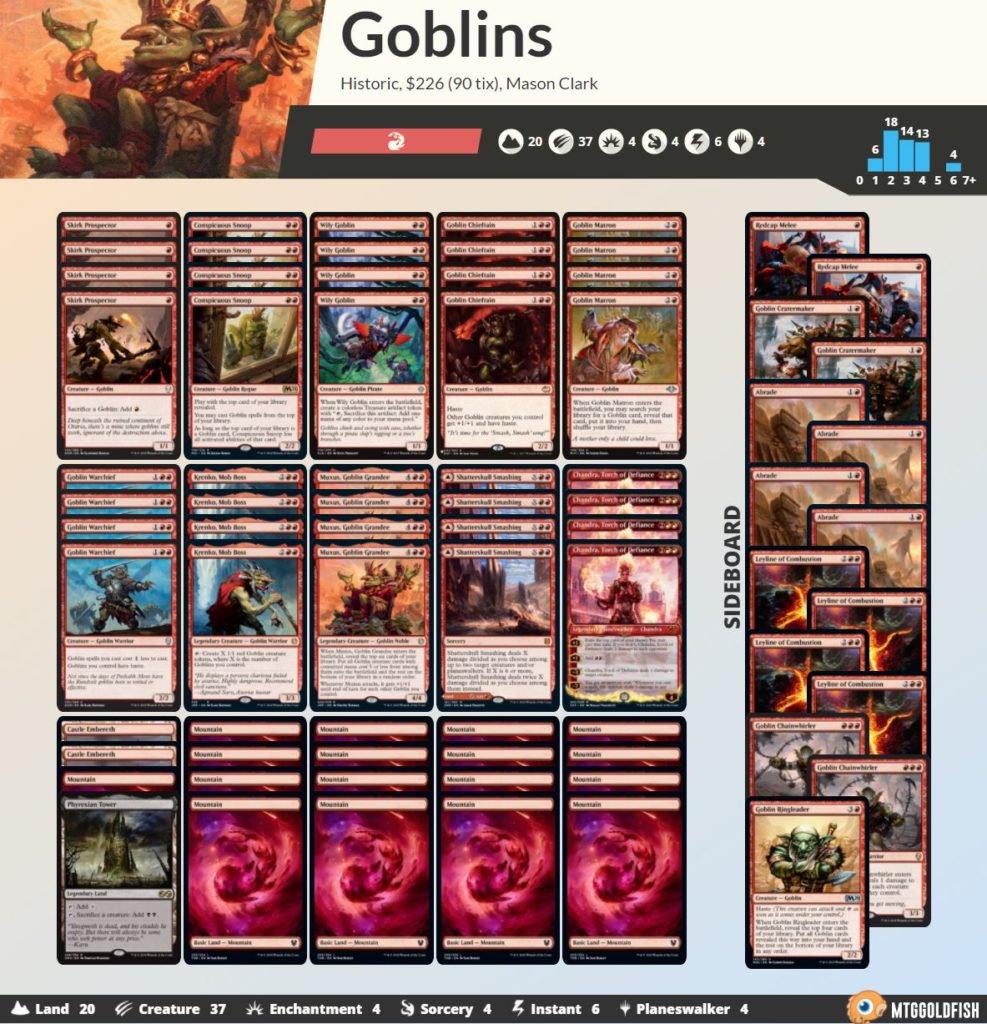
Buy this deck from Card Kingdom
Export this deck to Arena via MTGGoldfish
Goblins sees the biggest jump since our last tier list, where (to the horror and amusement of many) I put it in D Tier. The following weekend at the Mythic Championship, it showed up BIG TIME. But while the deck had a great Day 2 conversion rate, it only put one player into the Top 8, and only two players brought it to the Grand Finals.
Goblins has remained a very beatable deck, plagued by inconsistent draws — fine for ladder, but sometimes a death sentence at a major event. But, with the release of Kaladesh, Goblins gained access to Chandra, Torch of Defiance, which solves many of the deck’s problems. Chandra provides the two mana you need to play Muxus the following turn, and she also generates card advantage that will allow you to go even longer against grindy decks. She can even kill a key creature from your opponent when she has to. Chandra is a staple in this deck, as far as I’m concerned, and she’ll help you battle through a lot of the hate in Historic.

Blue-White Control

Buy this deck from Card Kingdom
Export this deck to Arena via MTGGoldfish
Starting off B tier is old faithful Blue-White Control, which hasn’t gained much in the last few sets outside of Torrential Gearhulk. (And the jury’s still out on how playable Gearhulk is, given its weakness to Mystical Dispute.) Blue-White is a planeswalker-heavy deck that looks to take over the game and win with a Teferi ultimate. You also have access to the “Splinter Twin” combination of Gideon of the Trials and Pact of Negation in the early game — you get “free” counterspells since Gideon will prevent you from losing if you can’t pay for Pact.
This deck is typically very good against the S-tier decks in the format, but can struggle against other popular archetypes. Historic is just a bit too wide for Control to be successful right now, especially when the deck lacks a way to quickly win the game.
Mono-Red
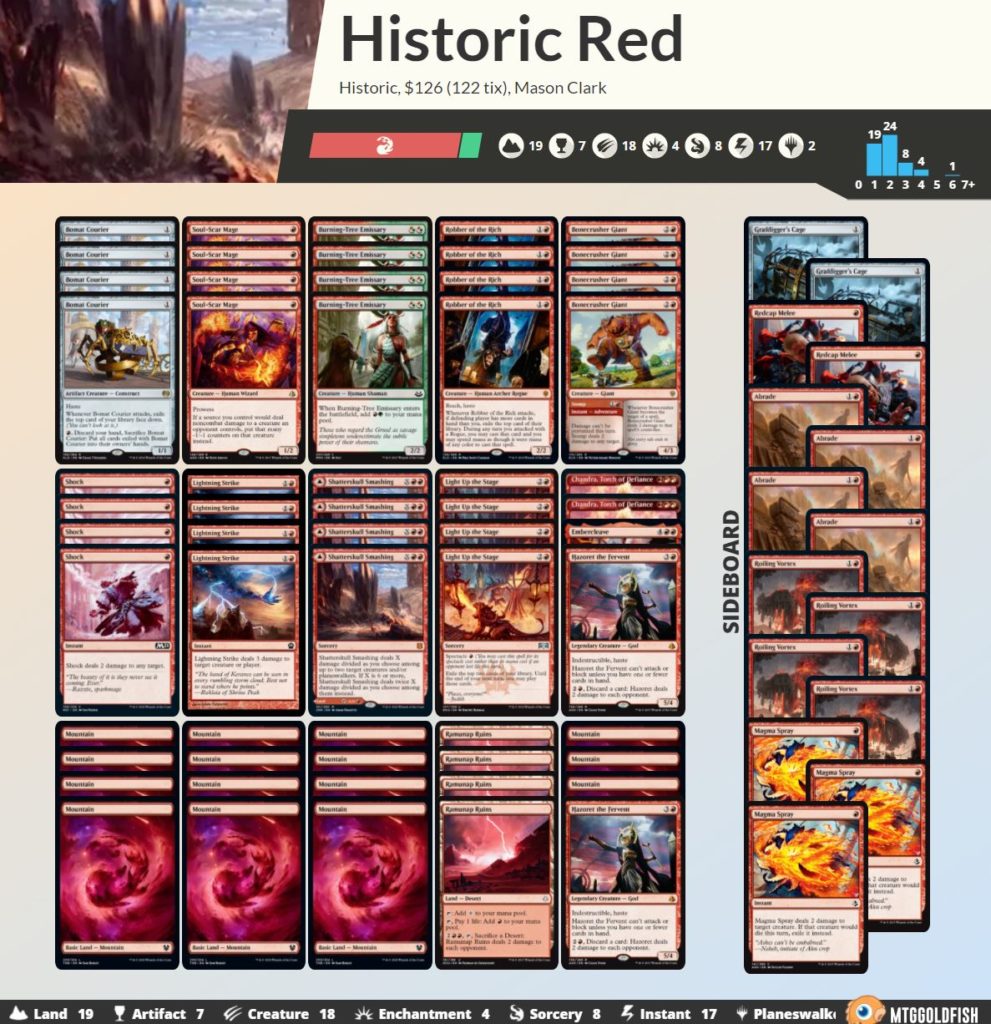
Buy this deck from Card Kingdom
Export this deck to Arena via MTGGoldfish
Last time we talked about Historic, Mono-Red was firmly in A tier. As the metagame has evolved, Gruul has outshined Red, while also becoming much more hostile to Red itself. The burn-heavy Experimental Frenzy version of Mono-Red has since fallen by the wayside, giving way to Embercleave-focused builds. Just like Gruul, this deck uses Burning-Tree Emissary to allow for more turn three Embercleaves, but it also has Kari Zev to enable similar draws. These creatures don’t wear the Cleave quite as well as Gruul’s, but your consistent mana is a huge selling point. This deck also got Bomat Courier and sideboard Chandra’s with Kaladesh, both of which will allow you to refuel in the mid-game.
Even with all those perks, the average card quality in this deck is substantially lower than Gruul’s. You typically have to rely on your opponents to stumble when you don’t have an Embercleave, and that’s not a place I’d love to be.

Neo Storm
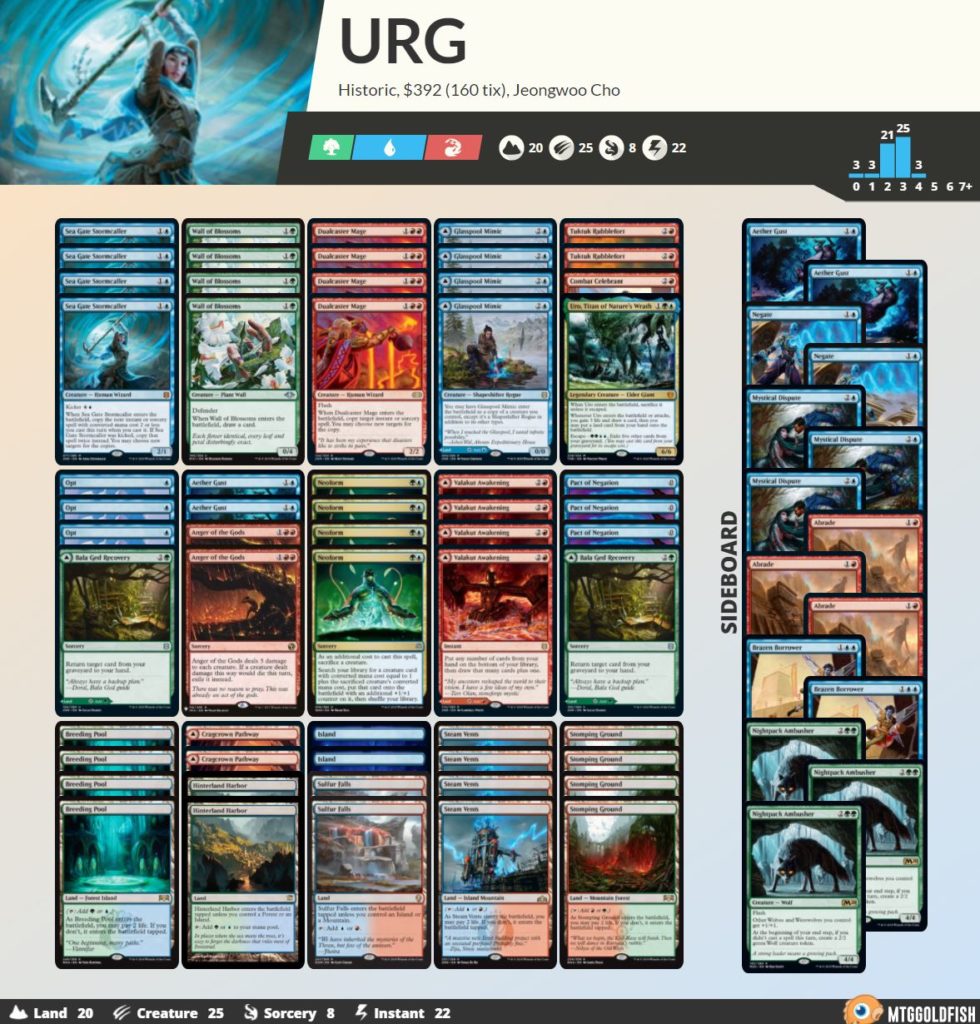
Buy this deck from Card Kingdom
Export this deck to Arena via MTGGoldfish
This newer Historic deck tries to combo off by casting a Sea Gate Stormcaller, then using Neoform and Dualcaster Mage to flood the board with 3/2’s and attack. It’s a surprisingly potent strategy, and one that can catch people off guard if they’re not expecting it. However, the deck is very weak to cards like Grafdigger’s Cage, which are all over the place in this format. Neo Storm is the definition of a C tier deck: totally fine, but not taking the world by storm (ironically).
Marvel
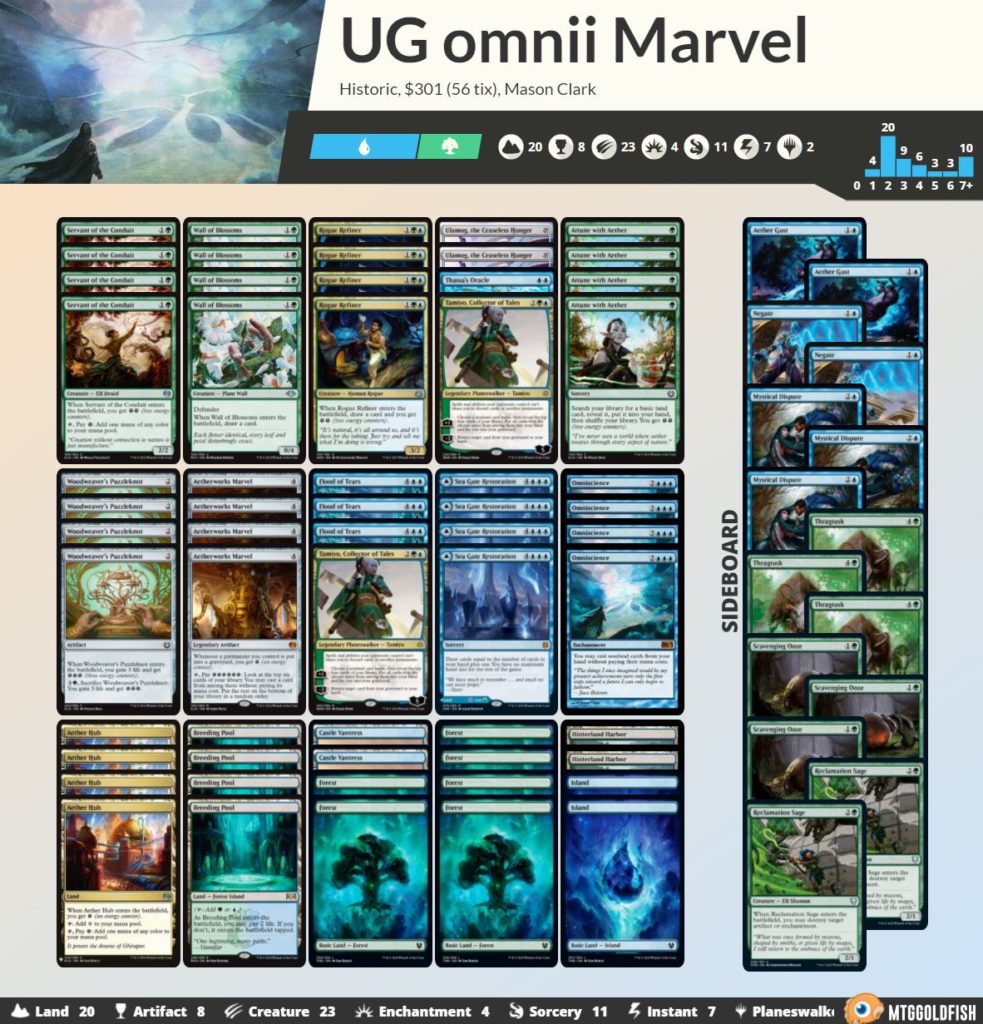
Buy this deck from Card Kingdom
Export this deck to Arena via MTGGoldfish
Marvel is just a couple days old at time of writing, and Historic players’ opinions on it vary. I personally think the deck is still finding its place, but the build I have the most faith in is UG Omniscience. Your goal is to play Omniscience with Marvel, move through your deck, and win with Thassa’s Oracle — or just do normal Marvel shenanigans. Your deck doesn’t really have a backup plan or the “fair” game plan we saw from the Standard version, but I think that’s okay. The creature options in Historic aren’t the best for this deck, so you should just lean into doing busted stuff.
This deck has lots of flaws, from being flooded on expensive spells to the inability to consistently beat cards like Grafdigger’s Cage. But, with time, Marvel could be a B-tier deck.
Paradox Storm
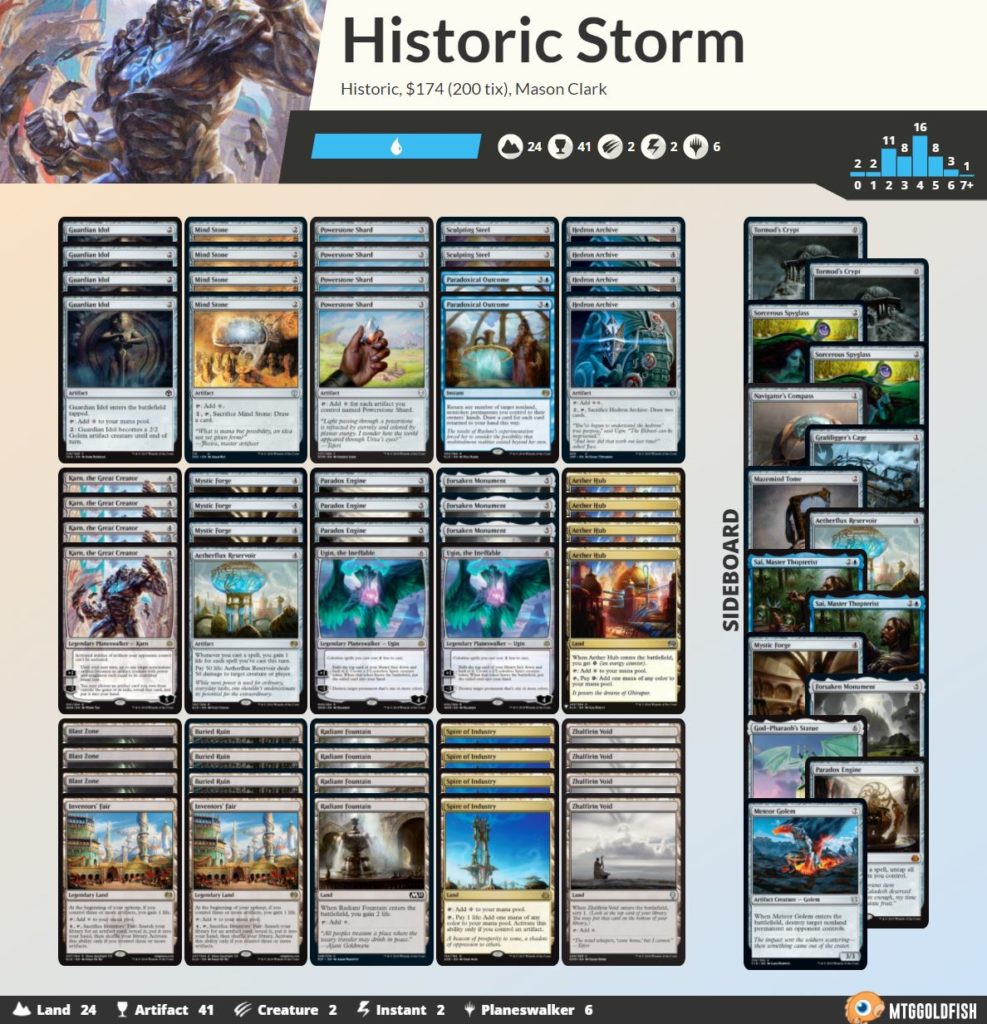
Buy this deck from Card Kingdom
Export this deck to Arena via MTGGoldfish
Our last deck in C tier is one that I highlighted in my last article. Paradox Storm uses powerful artifacts like Mystic Forge, Aetherflux Reservoir, and Paradox Engine to churn through your deck and eventually deal 50 damage. The deck has some seriously powerful draws — I’ve won as early as turn five with it — but it also tends to completely flood out. It also doesn’t have a real plan against aggro decks; you have some Sai’s in the board that can chump block for a couple turns, but most of the time, they’re just going to run you over. If you’re looking to work on this deck, maybe incorporating white so you can play Wrath of God is the solution.
The Historic format is very deep, and people are playing a lot of different decks. It’ll be very exciting to keep an eye on this weekend’s tournament results to see what comes out on top of the dogpile. I expect this format has some hidden gems we don’t even know about yet, and I’m looking forward to seeing what decks will emerge in the coming weeks.
What deck do you love to ladder with in Historic? Tweet your spiciest lists at @masoneclark and @card_kingdom!

Mason Clark is a grinder in every corner of the game who has played at the pro level and on the SCG Tour with Team Nova. Whether he’s competing in Standard, Historic or Modern, Mason plays with one goal in mind: to be a better player than he was the day before. Check out his podcast, Constructed Criticism, and catch his streams on Twitch.

